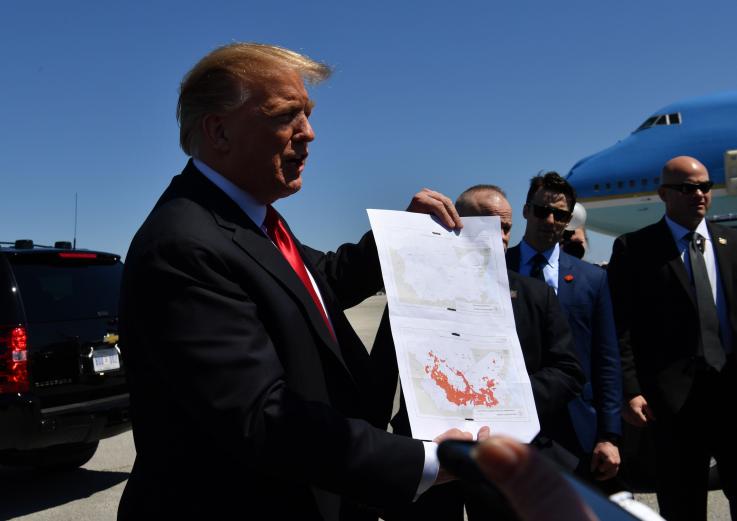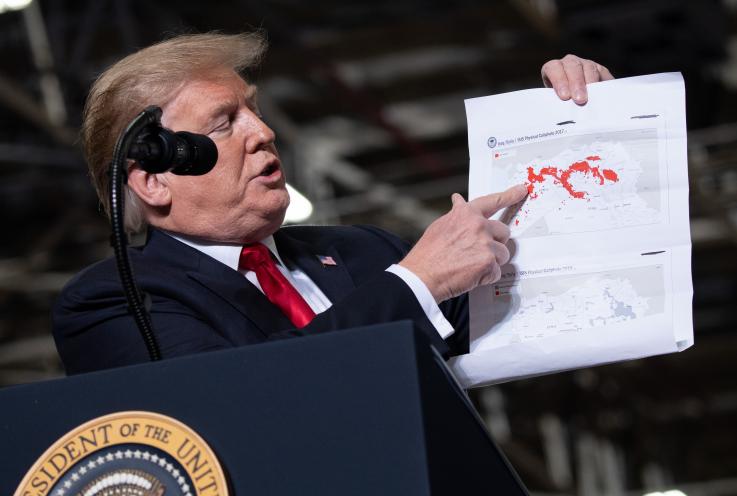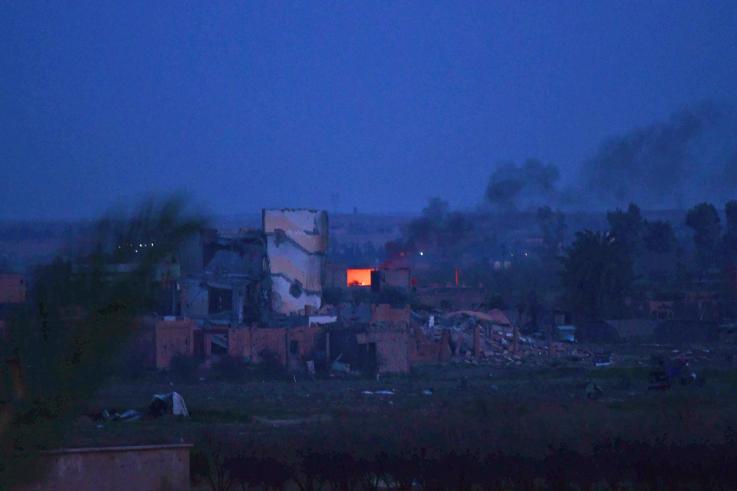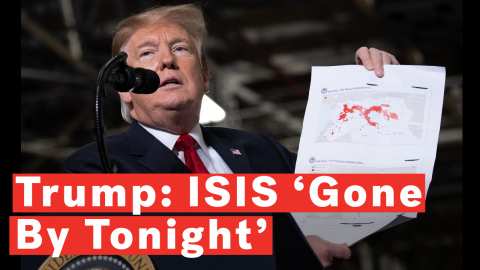Donald Trump Says ISIS Defeated for at Least the Tenth Time
ANGLO AMERICA, MILITARISM, MIDDLE EAST AND NORTH AFRICA, SYRIA IN CONTEXT, 25 Mar 2019
22 Mar 2019 – President Donald Trump has repeatedly declared victory over the Islamic State militant group (ISIS) throughout his term, even as embattled jihadis continued to put up resistance to U.S.-backed forces.
Upon his arrival in Palm Beach, Florida, on Friday, Trump once again pronounced ISIS dead to reporters, touting a map purporting to show the total collapse of the militants’ self-proclaimed caliphate that once spanned large areas of Iraq and Syria from 2014—the year former President Barack Obama launched a U.S.-led coalition to defeat the group—until “last night.” “Congratulations,” Trump said, “you guys can have the map.”
The president made a similar announcement Wednesday during a visit to a tank factory in Lima, Ohio. There, too, he showed off a map, except this one compared the “physical caliphate” between 2017—the year Trump took office—and this year, which continued to show large gray zones of “residual ISIS presence” absent from Friday’s map.
Trump ignored those regions in his remarks, indicating only “a tiny spot” that represented the final ISIS stronghold of Baghouz in Syria’s far eastern Deir ez-Zor province. He predicted that “the caliphate is gone as of tonight” and, in comments that have become familiar to observers, the White House declared Friday that ISIS was “100 percent defeated.”

President Donald Trump with a map indicating the end of ISIS, arriving at Florida’s Palm Beach International Airport on March 22. The above graphic indicates the jihadis’ territory across Iraq and Syria as of 2019, while below shows the group’s presence in 2014. NICHOLAS KAMM/AFP/Getty Images
Trump inherited Obama’s battle against ISIS at the peak of its intensity. The Republican leader took the reigns of Operation Inherent Resolve just as allied Iraqi and Syrian forces were approaching the major jihadi strongholds of Mosul and Raqqa, introducing a deadly urban phase of the fight that saw a massive uptick in casualties. ISIS lost control of its largest city in Iraq in July 2017, and its de facto capital in Syria in October 2017.
The following month, the Syrian government—which waged a separate campaign backed by Iran and Russia against ISIS and other, once-U.S.-backed rebels—declared victory over ISIS. A month after that, the Iraqi government made its own victory speech. Even Russian President Vladimir Putin claimed that he and his allies “defeated the most battle-ready grouping of international terrorists” that same December, more than a year ago.
The White House responded with skepticism, with a National Security Council spokesperson telling Reuters that “Russian declarations of ISIS’s defeat are premature.” Trump himself, however, said that same day that the U.S. had “won in Syria, we’ve won in Iraq” against ISIS. He told reporters on Air Force One the previous month that “ISIS is virtually defeated in the Middle East.”
As the U.S.-backed Iraqi military and Iran-backed militias supporting them consolidated their gains in early 2018, the conflict in Syria saw renewed fighting between the U.S.-backed Kurds and fellow U.S. ally Turkey, which branded some of them terrorists due to alleged thinks to a separatist insurgency at home. The Syrian Democratic Forces, a mostly Kurdish militia operating with the U.S.-led coalition’s support, continued to battle ISIS, while at the same time facing off with Turkish troops and allied Islamist rebels formerly supported by U.S. as the separate pro-Syrian government campaign tackled insurgents and jihadis alike.

President Donald Trump holds up a map detailing territory losses by ISIS in Syria as he speaks following a tour of the Lima Army Tank Plant at Joint Systems Manufacturing in Lima, Ohio, March 20. This map compared losses from 2017—the first year of Trump’s presidency—to 2019 and included large gray splashes of “residual ISIS presence” omitted from the March 22 map. SAUL LOEB/AFP/Getty Images
Though the conflict had grown more complex, ISIS had clearly become the biggest loser after seven years, and just shy of the March 15 anniversary of the rebel and jihadi uprising that sparked the unrest, Trump told a crowd gathered in Ohio that the U.S. would be “coming out of Syria, like, very soon.” He told his defense officials the following month that the U.S. had “beaten ISIS,” taking “just about 100 percent of the caliphate.”
He reversed course on the withdrawal shortly afterward, launching new strikes against the Syrian government in response to an alleged chemical weapons attack and emphasizing the need to curb growing Iranian influence in Syria. Still, he continued to boast his victory against ISIS throughout the year.
He told a press a September 2018 press conference in New York that “we have defeated ISIS, essentially, very short while ago in the Middle East.” The following month, told the Associated Press “we’ve defeated ISIS, ISIS is defeated in all of the areas that we fought ISIS, and that would have never happened under President Obama.” Trump was soon joined by Turkish President Recep Tayyip Erdoğan, who proclaimed “there is no ISIS in Syria” during a speech in November.
The real coup came in December. Trump once again proclaimed that he had “defeated ISIS in Syria” and, for the second time, called for a withdrawal from the country as battling the jihadis was his “only reason for being there.” Those Twitter remarks reportedly came as a shock to his top generals—like Secretary James Mattis, who resigned days later—and foreign policy officials, prompting Secretary of State Mike Pompeo and National Security Adviser John Bolton to quickly set out on Middle East tours to reassure regional allies.

Smoke rises over the village of Baghouz in the eastern Syrian province of Deir ez-Zor, March 22. The U.S.-backed Syrian Democratic Forces described “heavy fighting” that day, even as the White House declared ISIS “100 percent defeated.” GIUSEPPE CACACE/AFP/Getty Images
Trump appeared to again step back as the White House announced that around 200 troops would remain in Syria, which was joined by Russia and Iran in again calling for an immediate U.S. exit. Trump told NBC News in January that he had “beaten ISIS,” but speaking before members of the U.S.-led coalition early last month, he said that “it should be formally announced sometime probably next week that we will have 100 percent of the caliphate.”
The president signaled that his premonition came true at the beginning of this month, telling troops at Joint Base Elmendorf-Richardson in Anchorage, Alaska, that “you kept hearing it was 90 percent, 92 percent,” but now “100 percent” of the so-called caliphate had been destroyed. The statement came the same day that Syrian Democratic Forces commander Mazloum Kobani announced his fighters had just begun the “operation to clear the last remaining pocket of ISIS” in the village of Baghouz.
The Syrian Democratic Forces have since entered Baghouz and have begun facing off with what may very well be the last of the caliphate. As of Friday, however, Syrian Democratic Forces spokesperson Mustafa Bali maintained that “heavy fighting continues” in the final push against ISIS.
DISCLAIMER: The statements, views and opinions expressed in pieces republished here are solely those of the authors and do not necessarily represent those of TMS. In accordance with title 17 U.S.C. section 107, this material is distributed without profit to those who have expressed a prior interest in receiving the included information for research and educational purposes. TMS has no affiliation whatsoever with the originator of this article nor is TMS endorsed or sponsored by the originator. “GO TO ORIGINAL” links are provided as a convenience to our readers and allow for verification of authenticity. However, as originating pages are often updated by their originating host sites, the versions posted may not match the versions our readers view when clicking the “GO TO ORIGINAL” links. This site contains copyrighted material the use of which has not always been specifically authorized by the copyright owner. We are making such material available in our efforts to advance understanding of environmental, political, human rights, economic, democracy, scientific, and social justice issues, etc. We believe this constitutes a ‘fair use’ of any such copyrighted material as provided for in section 107 of the US Copyright Law. In accordance with Title 17 U.S.C. Section 107, the material on this site is distributed without profit to those who have expressed a prior interest in receiving the included information for research and educational purposes. For more information go to: http://www.law.cornell.edu/uscode/17/107.shtml. If you wish to use copyrighted material from this site for purposes of your own that go beyond ‘fair use’, you must obtain permission from the copyright owner.
Read more
Click here to go to the current weekly digest or pick another article:
ANGLO AMERICA:
- Washington Green-Lights $30M for Gaza Aid Scheme Tied to Mass Killings of Palestinians
- War with Iran: We Are Opening Pandora's Box
- Trump’s Useful Idiots
MILITARISM:
- The Transatlantic Split Myth: How U.S.-Europe Militarization Thrives behind the Rhetoric
- Mapping Militarism 2025
- The Limitations of Military Might
MIDDLE EAST AND NORTH AFRICA:
- Persia, Iran, and the Great Arab Mix-up: A Sarcastic Stroll through History to Today’s Messy War
- Will Israel Continue to Attack Iran until the International Community Approves the Eradication of Palestine?
- Crusade against Iran and the Complicity of Western Decadent Civilizations
SYRIA IN CONTEXT:
